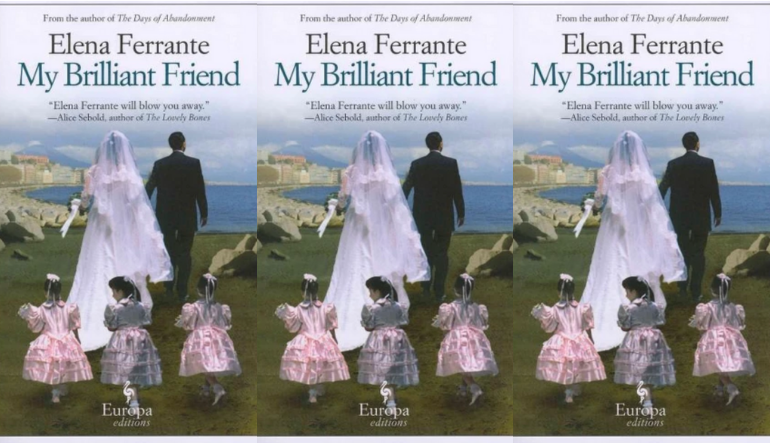On Intimacy: Elena Ferrante & Stacey D’Erasmo

Elena Ferrante’s novels are often dubbed “intimate.” Meghan O’Rourke writes in The Guardian, “As fiction, they are both deeply realist and surprisingly intimate.” The LA Times notes that one novel in particular “is as expansive and broad as it is intimate.” It seems as though people do not want to believe that fiction can be intimate—that is: detailed, personal, private, sacred, something with which readers feel closely acquainted or familiar. It is especially surprising if it is also broad, and that one book can accomplish both apparently astounds reviewers.
Why is this so astounding? What is so intimate about the novels of Elena Ferrante? What is intimacy in literature, anyway? Stacey D’Erasmo asks similar questions in The Art of Intimacy: “What is the nature of intimacy, of what happens in the space between us? And how do we, as writers, catch or reflect it on the page?”
“What happens in the space between us” is a striking phrase, and serves as an unofficial and guiding definition of intimacy: the space between two people or two things, which is filled or bridged by something or someone. The definition is vague because intimacy takes many forms—D’Erasmo writes that it’s not only reserved for romantic relationships between consenting adults. “Friendships, the bonds of parents and children, the fleeting communion of strangers at a dinner party or on a train or a plane, crushes, being deeply moved by art or by a historical event, the relationship between a reader and writer: in all of these, that space between is vital, electric, and it often drives the story.”
D’Erasmo doesn’t ask how one should write intimacy—she asks how writers can “catch or reflect” it in their writing, as if intimacy is not something to manufacture. Though we construct plots, settings, and dialogue, it seems crass to fabricate intimacy. “Like looking directly at the sun, looking directly at the creation of intimacy in fiction seems like a dangerous business. In art as in life, one wishes intimacy to be, or at least to seem, unspoken, unmanipulated, certainly unforced.”
Creating intimacy, forcing it, might smack as saccharine, and D’Erasmo notes that “one word for low-level writing about intimacy might be sentimental,” as emotions “are slathered thickly […], muffling the emotions that might be more complex, more resistant, more ambiguous.”
Ferrante’s novels are cheered for their intimacy and lack of sentiment—that is, their complexity and ambiguity. The author allows emotion to stretch out on the page, sometimes to uncomfortable proportions, as is the case in Troubling Love and The Days of Abandonment. Readers and reviewers seem stunned to perceive intimacy, given that the novels can be so dark, set against a backdrop of violence. The limitations of intimacy are even inherent in the characters’ native dialect: “The coarse language of the environment we came from was useful for attack or self-defense, but, precisely because it was the language of violence, it hindered, rather than encouraged, intimate confidences.”
Elena and Lila’s relationship is not all friendship bracelets and flower crowns—it is fraught, tenuous, and (like the three characters in Sloane Crosley’s The Clasp) as they grow, they wonder how their friendship fits together. Whatever the reason, it is the point-of-view of the Neapolitan Novels that lend Elena and Lila their closeness. One reviewer writes, “The two women recall Michel de Montaigne’s idea that true friends ‘mix and blend one into the other [in] so perfect a union that the seam which has joined them is effaced and disappears.’ Montaigne was speaking sentimentally, though: There is no pure harmony here.”
Intimacy does not mean harmony. D’Erasmo notes that “The intimacy that can seam can also rend, and the writer’s task is similar: to draw readers into that dark space and to persuade them of its meaning and its gravity.”
The seams that join Elena and Lila were “effaced and disappear[ed].” There is no space between the two, no definite point where one ends and the other begins. D’Erasmo, writing about perspective in Passing by Nella Larsen, notes that “[the author] blurs the two women at the root: point of view.” In Passing, “we only see Clare through her (often narrowed) eyes.” The same could be written about the Neapolitan Novels, where Lila often narrows her eyes and experiences “dissolving margins,” while Elena’s vision blurs as an adolescent. The “oscillation” between Elena and Lila creates not harmony but intimacy, and diminishes the space between them: “When Lila’s pace becomes unsustainable, the reader grabs onto Elena. But if Elena falls apart, then the reader relies on Lila” (The Paris Review).
Maybe the intimacy of Elena Ferrante’s novels is surprising to us because of what D’Erasmo calls “the ubiquitousness, the cheapness even, of intimacy as a modern ideal.”
A particularly modern, faux-sincere, kitsch intimacy sells everything from afternoon talk shows to pictures on Instagram to Facebook’s endlessly mined person information, so glittering to retailers. We are continually willing to buy access to some inner zone or other, to the truth, the inside story, the ‘unretouched photo.’ But as Charles Baxter has put it, ‘Intimacy suggests a possibly sexualized, almost sacred location of space, a closeness that not everyone can share.’ To which the average marketer might reply, ‘So you mean a limited edition kind of thing?’
The Neapolitan Novels achieves a closeness so successful that Meghan O’Rourke wrote, it “is so deeply intimate that one is tempted to conflate Elena Greco with Elena Ferrante […].” When O’Rourke communicated with novelist Claire Messud, guest editor of the Summer 2016 issue of Ploughshares with James Wood, Messud e-mailed, “When you write to me and say you love her work, I have a moment where I think, ‘But … Elena is my friend! My private relationship with her, so intense and so true, is one that nobody else can fully know!’ It’s strange – and rare – to feel proprietary of a book, or a writer, in that way.”
Intimacy with a work of art does not give way to a closeness with the artist. As Dani Shapiro reminds readers in a recent piece for The New York Times, we often confuse the writer’s word with their lives.
But there is a profound difference between what a writer does alone in her room — the honing, crafting, shaping, transcending of her own personal history in order to carve out a story that is ultimately a public performance — and the human need to quietly share in the most intimate possible way, to confess, to stutter out thoughts and feelings, to be heard and understood.
Yes, reading a book can be an intimate experience: wholly personal, as if writer and reader are the only two who exist. It is tempting to connect the story to the hand that penned it. We assume that this person’s life fits into neat little boxes—narrative, structure, syntax—and there’s nothing we can gain in their re-telling of it. This is too simple, too idealistic, too narrow—much like many of our unexamined assumptions of what intimacy is or should be (which includes gender stereotypes and conventional ideas of sex and sexuality). D’Erasmo writes, “Intimacy is not a good place to go for ideals, humans being what they are. But it is a tremendously fertile zone for all the emotions and mental states for which we have a name, and many for which we have no name at all.”

